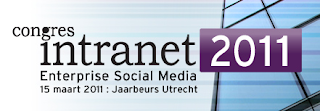The 2015 intranet - Anywhen, Anywhere by Martin White @intranetfocus #intra11

I still have one more post from the Intranet Conference ( Congres Intranet ) for you! Martin White closed the conference with a talk about The 2015 Intranet - Anywhen, Anywhere. White's talk can be easily summarized: Mobile First. The internet is moving to mobile, the intranet is as well. White has been researching this topic and has interesting (upcoming) reports about this topic. The number of users with mobile web access is astounding (refer to picture). White also doesn't not believe in a future for mobile apps. He says develop for the mobile web, not apps. It's way too expensive to develop apps for all the different platforms. The real value of mobile intranet will be in the area of business intelligence, says White. Mobile intranet supports the real-time enterprise. IT needs to address this trend. Also with respect to security (lots of devices are left behind/lost). Usability and mobile: speech, typing. Don't push you're whole intranet through the mobile. Yo...
















